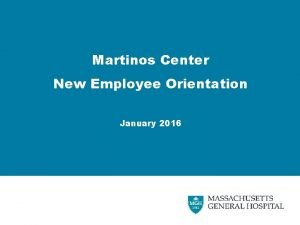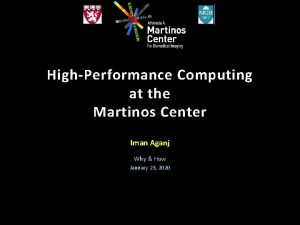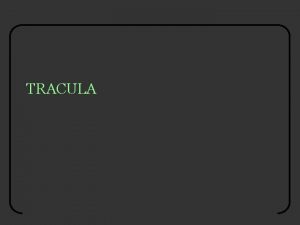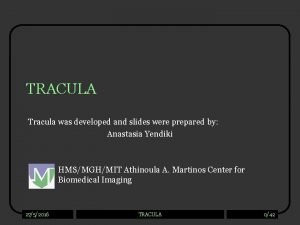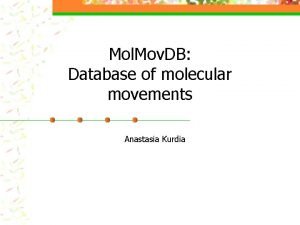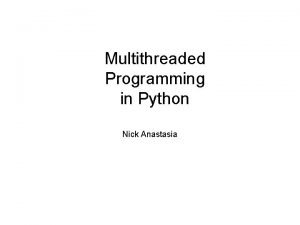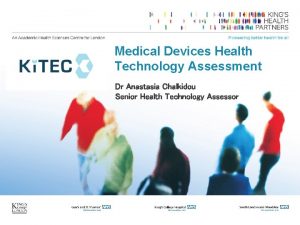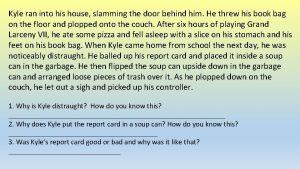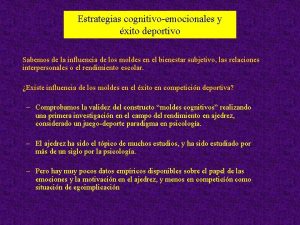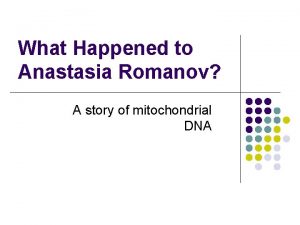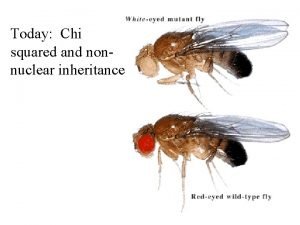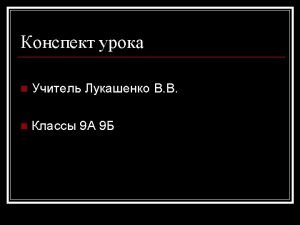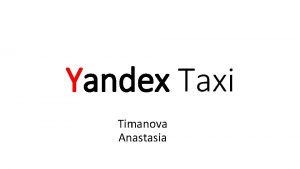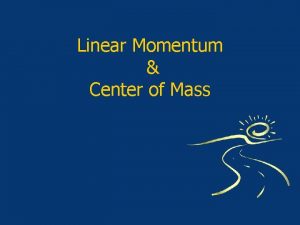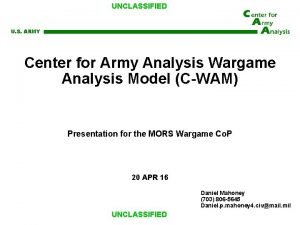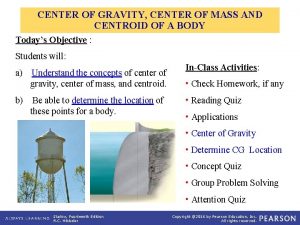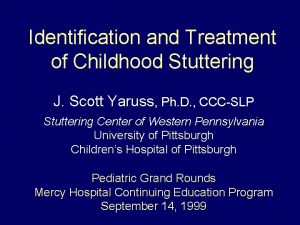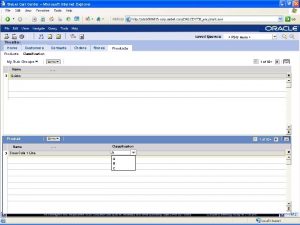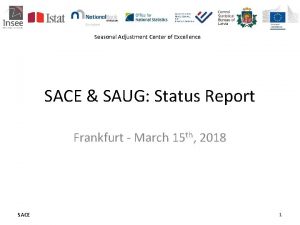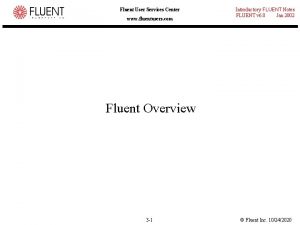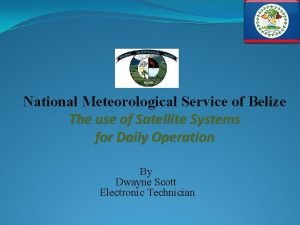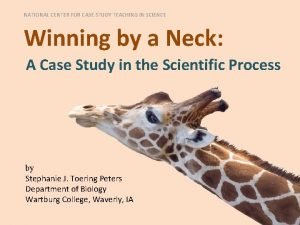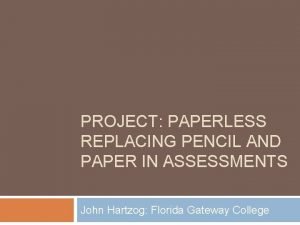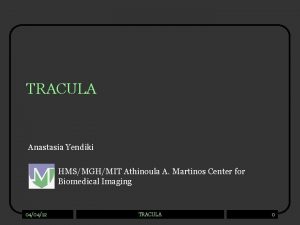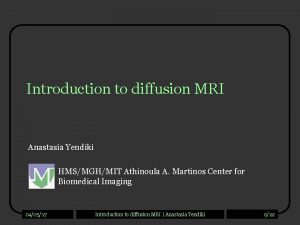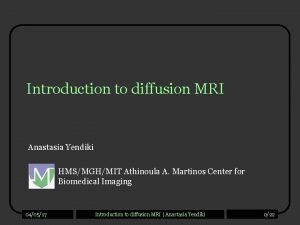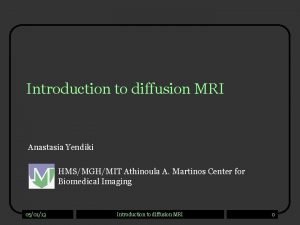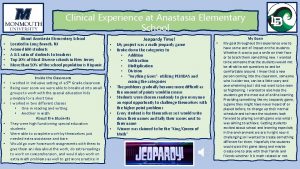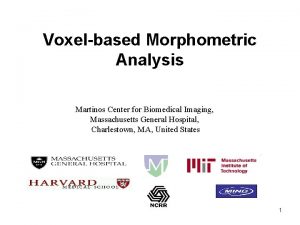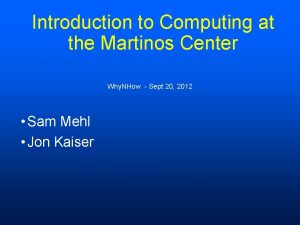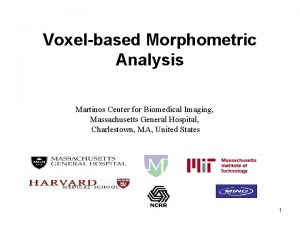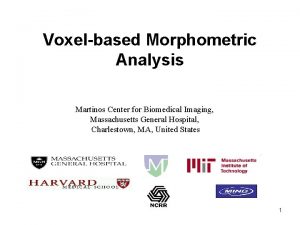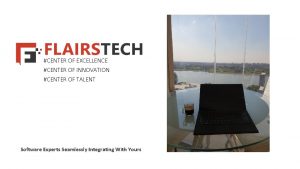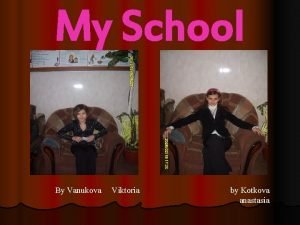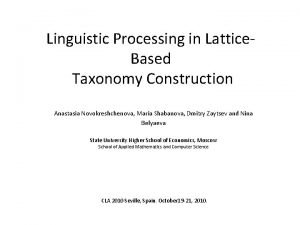TRACULA Anastasia Yendiki HMSMGHMIT Athinoula A Martinos Center













![White-matter pathway atlas • Labeling based on an established protocol [Wakana ‘ 07] • White-matter pathway atlas • Labeling based on an established protocol [Wakana ‘ 07] •](https://slidetodoc.com/presentation_image/29d7a45eefd1a2273857199ae2a70076/image-14.jpg)































- Slides: 45

TRACULA Anastasia Yendiki HMS/MGH/MIT Athinoula A. Martinos Center for Biomedical Imaging 04/05/17 TRACULA | Anastasia Yendiki 0/44

Data analysis steps • Pre-process images to reduce distortions – Either register distorted DW images to an undistorted (non-DW) image – Or use information on distortions from separate scans (field map, residual gradients) • Fit a diffusion model at every voxel – Tensor, ball-and-stick, ODF, … • Do tractography to reconstruct pathways and/or • Compute measures of anisotropy/diffusivity and compare them between populations – Voxel-based, ROI-based, or tract-based statistical analysis 04/05/17 TRACULA | Anastasia Yendiki 1/44

Tractography studies • Exploratory tractography: – Example: Show me all regions that the motor cortex is connected to. – Seed region can be anatomically defined (motor cortex) or functionally defined (region activated in an f. MRI finger-tapping task) ? • Tractography of known pathways: – Example: Show me the corticospinal tract. – Use prior anatomical knowledge of the pathway’s terminations and trajectory (connects motor cortex and brainstem through capsule) 04/05/17 TRACULA | Anastasia Yendiki 2/44

Tractography methods • Every tractography method can be characterized by: – Which model of diffusion does it use? • Representation of local orientation of diffusion at every voxel that is fit to image data (tensor, ball-and-stick, etc. ) – Is it deterministic or probabilistic? • Deterministic estimates only the most likely orientation • Probabilistic also estimates the uncertainty around that – Is it local or global? • Local fits the pathway to the data one step at a time • Global fits the entire pathway at once • • • DTK/Trackvis: local, deterministic, DTI or Qball or DSI model FSL/probtrackx: local, probabilistic, ball-and-stick model TRACULA: global, probabilistic, ball-and-stick model 04/05/17 TRACULA | Anastasia Yendiki 3/44

Deterministic vs. probabilistic • Deterministic methods give you an estimate of model parameters 5 • Probabilistic methods give you the uncertainty (probability distribution) of the estimate 5 04/05/17 TRACULA | Anastasia Yendiki 4/44

Deterministic vs. probabilistic Sample 1 Sample 2 … Deterministic tractography: Probabilistic tractography: One streamline per seed voxel Multiple streamline samples per seed voxel (drawn from probability distribution) 04/05/17 TRACULA | Anastasia Yendiki 5/44

Deterministic vs. probabilistic Deterministic tractography: Probabilistic tractography: One streamline per seed voxel A probability distribution (sum of all streamline samples from all seed voxels) 04/05/17 TRACULA | Anastasia Yendiki 6/44

Local vs. global Local tractography: Fits pathway step-by-step, using local diffusion orientation at each step 04/05/17 Global tractography: Fits the entire pathway, using diffusion orientation at all voxels along pathway length TRACULA | Anastasia Yendiki 7/44

Local tractography • Best suited for exploratory study of connections • All connections from a seed region, not constrained to a specific target region • How do we isolate a specific white-matter pathway? – Thresholding? – Intermediate masks? • Non-dominant connections are hard to reconstruct • Results are not symmetric between “seed” and “target” regions • Sensitive to areas of high local uncertainty in orientation (e. g. , pathaway crossings), errors propagate from those areas 04/05/17 TRACULA | Anastasia Yendiki 8/44

Global tractography • Best suited for reconstruction of known white-matter pathways • Constrained to connection of two specific end regions • Not sensitive to areas of high local uncertainty in orientation, integrates over entire pathway • Symmetric between “seed” and “target” regions • Need to search through a large solution space of all possible connections between two regions: – Computationally expensive – Sensitive to initialization 04/05/17 TRACULA | Anastasia Yendiki 9/44

Conventional multi-ROI method • • Get whole-brain tract solutions Draw ROIs that a tract must go through (manually or map from atlas) • Even with perfectly placed ROIs, you may not find the whole pathway! 04/05/17 TRACULA | Anastasia Yendiki 10/44

TRACULA Yendiki et al. , 2011 • TRActs Constrained by Under. Lying Anatomy • Global probabilistic tractography with priors on anatomical neighbors • Needs segmentation (aparc+aseg. mgz from structural stream) • Recommended to run TRACULA in FS 6. 0, even if your structurals were processed with a previous FS version 04/05/17 TRACULA | Anastasia Yendiki 11/44

How does it work? Yendiki et al. , 2011 • Posterior probability of path F given DWI data Y and segmentation A: p( F | Y, A ) ~ p (Y | F ) Likelihood p( F | A ) Prior Posterior + – p( Y | F ) : Uncertainty due to imaging noise Fit of pathway orientation to ball-and-stick model parameters [Behrens ‘ 03, Jbabdi ‘ 07] – p( F | A ) : Uncertainty due to anatomical variability Fit of pathway to priors on anatomical neighborhood from training set 04/05/17 TRACULA | Anastasia Yendiki 12/44
![Whitematter pathway atlas Labeling based on an established protocol Wakana 07 White-matter pathway atlas • Labeling based on an established protocol [Wakana ‘ 07] •](https://slidetodoc.com/presentation_image/29d7a45eefd1a2273857199ae2a70076/image-14.jpg)
White-matter pathway atlas • Labeling based on an established protocol [Wakana ‘ 07] • • Corticospinal tract Inferior longitudinal fasciculus Uncinate fasciculus Corpus callosum – Forceps major – Forceps minor • Anterior thalamic radiation • Cingulum – Cingulate (supracallosal) – Angular (infracallosal) • Superior longitudinal fasciculus – Parietal – Temporal 04/05/17 Intra/inter-rater errors: 1 mm/2 mm on average TRACULA | Anastasia Yendiki 13/44

White-matter pathway atlas • The pathways were labeled manually in a set of training subjects… • … and combined with the same subjects’ structural segmentations 04/05/17 TRACULA | Anastasia Yendiki 14/44

Overview • What TRACULA does do: • Global tractography (models the entire path between two regions => no concept of “stopping” half way between them) • Anatomical priors (models the likelihood of the anatomical neighborhood of a tract, point by point along the tract) + • What TRACULA does not do: • Exploratory tractography (where you supply a seed region) • Deterministic rules about where tracts should or shouldn’t go − it’s not simply a set of end ROIs for tracts from Free. Surfer 04/05/17 TRACULA | Anastasia Yendiki 15/44

TRACULA outputs • Posterior probability distribution of each pathway given data (3 D volume) • Tract-based diffusion measures (FA, MD, RD, AD, etc): – Average values over entire pathway – Average values at each intersection along a pathway 04/05/17 TRACULA | Anastasia Yendiki 16/44

Schizophrenia study Data courtesy of Dr. Randy Gollub and MIND Institute • Reconstruct pathways in 34 SZ patients and 23 healthy controls 04/05/17 Control 1 Control 2 Control 3 Patient 1 Patient 2 Patient 3 TRACULA | Anastasia Yendiki 17/44

Schizophrenia study Yendiki et al. , 2011 • Reconstruct pathways in 34 SZ patients and 23 healthy controls with – – No training subjects 30 healthy training subjects 15 healthy / 15 SZ training subjects 30 SZ training subjects • Evaluate distance b/w automatically reconstructed and manually labeled pathways 04/05/17 TRACULA | Anastasia Yendiki 18/44

Head motion in diffusion MRI • Head motion during a d. MRI scan lead to: – Misalignment between consecutive DWI volumes in the series – Attenuation in the intensities of a single DWI volume/slice, if the motion occurred during the diffusion-encoding gradient pulse – The former can be corrected with rigid registration, the latter can’t Low-b Direction 1 Direction 2 Direction 3 Direction 4 Direction 5 Direction 6 • Conventional EPI sequences for d. MRI ignore the problem – If motion in several directions underestimation of anisotropy – False positives in group studies where one group moves more – Effects more severe when higher b-values, more directions acquired 04/05/17 TRACULA | Anastasia Yendiki 19/44

Motion in a d. MRI group study Yendiki et al. , Neuroimage 2014 • 57 children with autism spectrum disorder (ASD) • 73 typically developing children (TD) • Ages 5 -12 • 195 total scans (some retest) • DWI: 3 T, 2 mm isotropic, 30 directions, b=700 s/mm 2 • Translation, rotation, intensity drop-out due to motion assessed • Outlier data sets excluded • Pathways reconstructed automatically with TRACULA Data courtesy of Dr. Nancy Kanwisher and Ellison autism study 04/05/17 TRACULA | Anastasia Yendiki 20/44

ASD vs. TD Yendiki et al. , Neuroimage 2014 Differences in d. MRI measures between groups with low differences in head motion Differences in d. MRI measures between groups with high differences in head motion 04/05/17 TRACULA | Anastasia Yendiki 21/44

TD vs. TD Yendiki et al. , Neuroimage 2014 Differences in d. MRI measures between groups with low differences in head motion Differences in d. MRI measures between groups with high differences in head motion 04/05/17 TRACULA | Anastasia Yendiki 22/44

Head motion, in summary Yendiki et al. , Neuroimage 2014 • Differences in head motion between groups can induce spurious group differences in diffusivity and anisotropy • General trend: Head motion RD , AD , MD –, FA • This is after registration-based motion correction • Match motion between groups and/or use a motion score as a nuisance regressor • Note that all this will address false positives, but not false negatives due to head motion in the data • Methods for tackling the problem during data acquisition are needed 04/05/17 TRACULA | Anastasia Yendiki 23/44

TRACULA usage • All processing options are defined in a configuration file, dmrirc • Step 1: Pre-processing (distortion compensation, registration, etc. ) trac-all -prep -c dmrirc • Step 2: Fitting of ball-and-stick model (FSL’s bedpostx) trac-all -bedp -c dmrirc • Step 3: Reconstruct pathways trac-all -path -c dmrirc 04/05/17 TRACULA | Anastasia Yendiki 24/44

Configuration file • Example configuration file: $FREESURFER_HOME/bin/dmrirc. example • The simplest configuration file possible, using all default options and only defining inputs: setenv SUBJECTS_DIR /path/to/fs/output/directory set subjlist = (subj. A subj. B …) set dcmlist = (/path/to/A/1. dcm /path/to/B/011 -1. dcm …) • If mri_convert can’t read gradient tables or b-value tables from your dicoms, you also need: set bveclist = (/path/to/bvecs-A. txt /path/to/bvecs-B. txt …) set bvallist = (/path/to/bvals-A. txt /path/to/bvals-B. txt …) • Can specify trac-all output directory different from recon-all $SUBJECTS_DIR: set dtroot = /path/to/tracula/output/directory 04/05/17 TRACULA | Anastasia Yendiki 25/44

Pre-processing trac-all -prep -c dmrirc • Includes the following steps: – – – – • Image corrections: -corr Quality assessment (motion scores from Yendiki et al. 2014): -qa Intra-subject registration (DWI to T 1) : -intra Inter-subject registration (T 1 to template) : -inter Anatomical masks and labels : -mask Tensor fit : -tensor Anatomical priors : -prior Can do some of the steps only (assuming previous steps have been done): – trac-all -corr -qa -c dmrirc • Or exclude some of the steps (assuming they have been done previously): – trac-all -prep -nocorr -noqa -c dmrirc 04/05/17 TRACULA | Anastasia Yendiki 26/44

Ball-and-stick model fit trac-all -bedp -c dmrirc • This step simply runs FSL bedpost. X to fit the ball-and-stick model of diffusion to every voxel in the brain mask • This can take a while, but it’s possible to run every slice in parallel • To specify the maximum number of anisotropic compartments per voxel (default: 2) 1 set nstick = 3 • This step doesn’t do actual tractography 04/05/17 TRACULA | Anastasia Yendiki 2 0 27/44

Pathway reconstruction trac-all -path -c dmrirc • Reconstruct the 18 pathways (or a subset) using a random sampling algorithm • Pick an initial guess for the path from the training subjects in the atlas (the only step that requires decent alignment between individual and atlas!) • At every iteration, perturb control points of path and compute its fit to diffusion data and to anatomical priors from atlas • To specify number of paths to sample (default: 7500) set nsample = 10000 04/05/17 TRACULA | Anastasia Yendiki 28/44

Visualization with freeview • There is a 4 D volume where all the pathway distributions that were estimated have been merged • Opening this file in freeview will display all distributions as isosurfaces, thresholded at 20% of their maximum value. 04/05/17 TRACULA | Anastasia Yendiki 29/44

Visualization: 3 D view • freeview dmri/dtifit_FA. nii. gz -tv dpath/merged_avg 33_mni_bbr. mgz Change threshold for display 04/05/17 TRACULA | Anastasia Yendiki 30/44

Visualization: 3 D view • freeview dmri/dtifit_FA. nii. gz -tv dpath/merged_avg 33_mni_bbr. mgz Change threshold for display 04/05/17 TRACULA | Anastasia Yendiki 31/44

Visualization: Slice view • freeview dmri/dtifit_FA. nii. gz -tv dpath/merged_avg 33_mni_bbr. mgz Change threshold for display 04/05/17 TRACULA | Anastasia Yendiki 32/44

Tract-based measures • Reconstruction outputs – Posterior probability distribution of pathway given data (3 D): paths. pd. nii. gz – Maximum a posteriori pathway (1 D): path. map. nii. gz • Tract-based diffusion measures (FA, MD, RD, AD) – Averaged over the entire pathway distribution: pathstats. overall. txt – As a function of position along the pathway: pathstats. byvoxel. txt 04/05/17 TRACULA | Anastasia Yendiki 33/44

Path stats (average values) pathstats. overall. txt • *_Avg: Average values of every voxel with probability > 20% of the maximum • *_Avg_Weight: Multiply value at voxel with the probability at that voxel, sum over every voxel with probability > 20% of the maximum – This is closest to the notion of mean/expected value • *_Center: Average values only on the 1 -D path with the highest probability 04/05/17 TRACULA | Anastasia Yendiki 34/44

Path stats (values along the path) pathstats. byvoxel. txt • At each position along the path AD_Avg RD_Avg – Value on 1 -D path with the highest probability – *_Avg: Average value over nearest points from all sampled paths • Coordinates are given in native diffusion space • Paths from different subjects generally have different number of positions along path 04/05/17 TRACULA | Anastasia Yendiki 35/44

Along-the-path analysis 04/05/17 • Compute average FA/MD/RD/AD at each cross-section of the pathway • Plot as a function of position along the pathway • Correspondence of points between subjects based on Euclidean distance in MNI space TRACULA | Anastasia Yendiki 36/44

New: Assemble group stats trac-all -stat -c dmrirc • Combine files of stats along the path from multiple subjects: – Interpolate values of FA/MD/… at the same arc lengths for all paths – Find mean path for visualizing group results • Outputs can be used for group studies on FA, MD, RD, AD along the pathway – One text file per pathway per measure (FA, MD, RD, AD) – Coordinates of mean path for visualization in freeview – Log file shows which subjects are outliers (shape-wise) 04/05/17 TRACULA | Anastasia Yendiki 37/44

Example: p-values along each tract • Save p-values in a simple text file, load it as a “scalar map” 04/05/17 TRACULA | Anastasia Yendiki 38/44

Tutorial • How to run TRACULA and view outputs: – Set up configuration file (input images, gradient directions, b-values, registration method, etc. ) – “Run” trac-all (don’t actually run it!) – Look at pathways in freeview – Look at FA, MD, and other stats for each pathway 04/05/17 TRACULA | Anastasia Yendiki 39/44

Longitudinal tractography • Goal: Reconstruct a white-matter pathway consistently among all time points of a subject • Challenging to do when processing each time point independently, as if it were a cross-sectional data point Time point 1 Time point 2 Time point 3 • Different parts of the pathway may be reconstructed in each time point, due to noise or white matter degeneration – Changes in average anisotropy/diffusivity may be underestimated – Point-to-point correspondence difficult to establish for along-thepath analysis of anisotropy/diffusivity 04/05/17 TRACULA | Anastasia Yendiki 40/44

Longitudinal TRACULA Yendiki et al. , Neuroimage 2016 T 1 base template T 1 base T 1 time point DWI time point [Reuter’ 10] [Greve’ 09] DWI time points • Reconstruct a subject’s pathways simultaneously in all time points: – – • • . . . Perturb path in the space of the base template Map to each time point Compute likelihood of DWI data at all time points Compute anatomical prior based on segmentations of all time points Ensures point-to-point correspondence along path between time points Unbiased, treats all time points the same way 04/05/17 TRACULA | Anastasia Yendiki 41/44

Longitudinal TRACULA: Sensitivity Yendiki et al. , Neuroimage 2016 • Improved sensitivity to longitudinal changes in FA in Huntington’s disease with longitudinal TRACULA : p<0. 1 *: p<0. 05 04/05/17 TRACULA | Anastasia Yendiki 42/44

Longitudinal TRACULA : Usage • Example configuration file: $FREESURFER_HOME/bin/dmrirc. long. example • List all time points and their corresponding base templates: set subjlist = (subj. A-tp 1 subj. A-tp 2 … subj. B-tp 1 subj. B-tp 2 …) set baselist = (subj. A-base. . subj. B-base …) • If baselist is not specified, data will be processed cross-sectionally • The same 3 steps of trac-all must be run for either cross-sectional or longitudinal stream (the only difference is in the configuration file) 04/05/17 TRACULA | Anastasia Yendiki 43/44

Coming soon! • Infant atlas (TRACULIn. A) • Improved adult atlas • Tool for exploratory studies on whole -brain data Sølsnes et al. , 2016 04/05/17 TRACULA | Anastasia Yendiki 44/44
 Martinos scanner schedule
Martinos scanner schedule Martinos email
Martinos email Tracula
Tracula Tracula
Tracula Molmov
Molmov Nick anastasia
Nick anastasia How often do you play it
How often do you play it Anastasia chalkidou
Anastasia chalkidou Why is kyle distraught
Why is kyle distraught Anastasia yakimova
Anastasia yakimova Anastasia romanov story
Anastasia romanov story Anastasia phillips age
Anastasia phillips age Chi square
Chi square Anastasia berezniak
Anastasia berezniak Anastasia gorokhova
Anastasia gorokhova ütv
ütv Anastasia salinger
Anastasia salinger Anastasia fiandaca
Anastasia fiandaca Avaya acccm
Avaya acccm Language center
Language center Center of mass of solid hemisphere
Center of mass of solid hemisphere Highveld training center
Highveld training center Difference between centre of mass and centre of gravity
Difference between centre of mass and centre of gravity Center for army analysis
Center for army analysis Averitt express canada
Averitt express canada Multimedia messaging service center
Multimedia messaging service center Center of mass
Center of mass Stuttering center of western pennsylvania
Stuttering center of western pennsylvania Shanghai technology innovation center
Shanghai technology innovation center Siebel call center
Siebel call center Mary g walsh writing center
Mary g walsh writing center Stc 035
Stc 035 Sace center
Sace center Jacobi hospital building 6
Jacobi hospital building 6 Workday at upenn
Workday at upenn Center for civic design
Center for civic design It center university of peradeniya
It center university of peradeniya No stem pin curl
No stem pin curl Fluent inc user services center
Fluent inc user services center Belize national meteorological service
Belize national meteorological service National center for case study teaching in science
National center for case study teaching in science Patent electronic business center
Patent electronic business center Paperless assessment center
Paperless assessment center Lvhn sleep center
Lvhn sleep center Uta maverick activity center
Uta maverick activity center Afcec reachback center
Afcec reachback center
